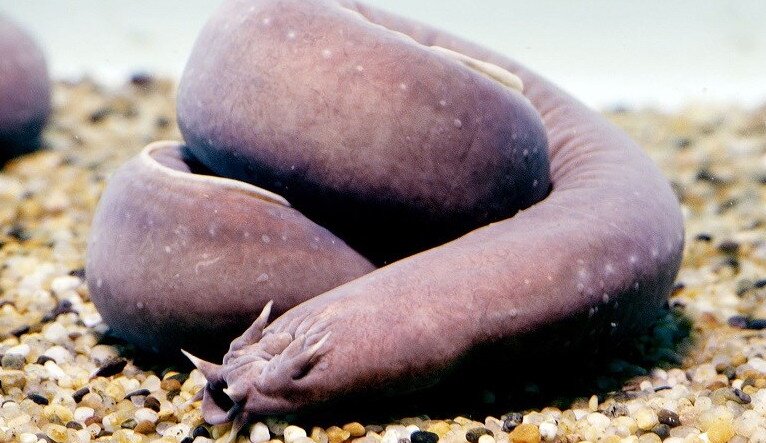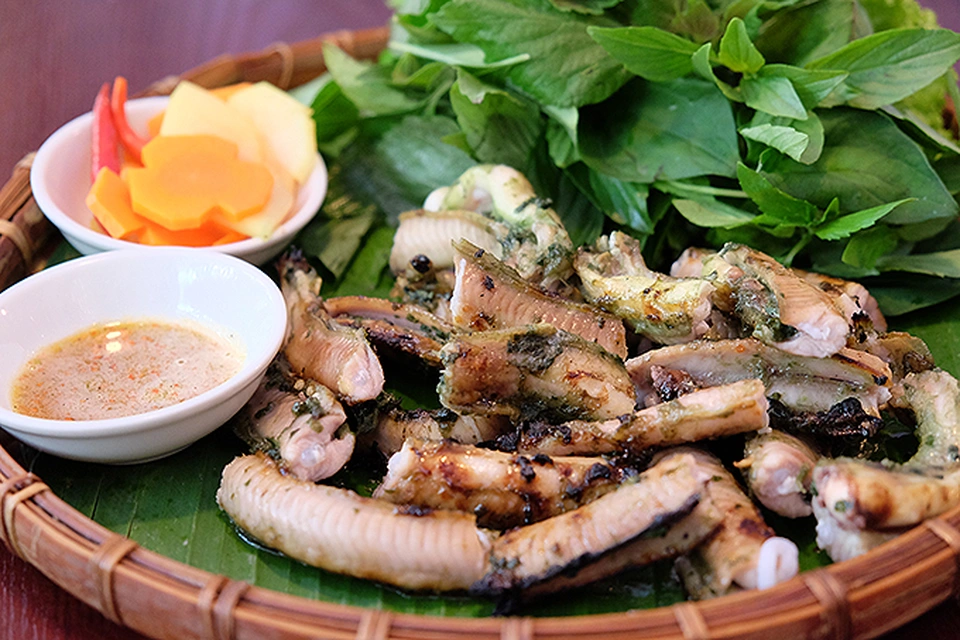
The Ninja Fish, also known as the Stone Sucker or Devil Fish, inhabits the depths of the ocean floor. Its appearance can be quite startling to those who see it for the first time: its body is slimy and eel-like, with a diameter of about 4cm and a length of roughly two forearm lengths. Its head resembles that of a loach with short whiskers, and its eyes are so tiny that they are almost unnoticeable, leading some fishermen to describe them as “nearly blind.” The tail is fan-like, and the body is covered with circular pores that constantly secrete a mucus-like substance. The most notable feature, however, is the absence of a backbone; instead, it has a white cartilaginous core as fragile as tender ribs.
When caught, the Ninja Fish tends to curl up and hide its head, leading to the common description of “hiding its head but revealing its tail.” Due to its elusive nature, camouflage-like coloration, and reclusive behavior, the locals of Binh Dinh province have aptly named it the Ninja Fish.
Local fishermen share that this fish cannot be caught using conventional methods; instead, it must be lured with a hook or trapped using a special type of net called a “giã cào.” Each fish typically weighs between 300-500g. There are two common varieties: the Black-backed Ninja Fish, with a dark back and white belly, usually found in shallower waters; and the Silky Ninja Fish, with a slender body and light pinkish skin, dwelling at depths of around 1,000m and considered the more delicious of the two.

It is only in the last five years that the Ninja Fish has gained widespread recognition among domestic diners. Prior to that, it was already established as a delicacy in South Korea and several European countries, where it is categorized as an expensive seafood item. In Vietnam, its unique flavor has gradually made it a favorite among restaurants and pubs, especially in the coastal cities of Central Vietnam.
At first glance, the Ninja Fish may evoke a sense of unease due to its eerie appearance, slimy body, and snake-like length. However, once prepared, it captivates diners with its fragrant, sweet, and chewy flesh. The most notable difference from other common fish is the meat’s resemblance to chicken in texture, while the cartilage is crisp and crunchy. Whether enjoyed as a beer snack or with steamed rice, the Ninja Fish leaves a lasting impression.
Currently, fresh Ninja Fish is priced at approximately 200,000–300,000 VND per kilogram, depending on the season. In addition to fresh fish, frozen and pre-prepared Ninja Fish is also available online throughout the year, delivered to various provinces.

Ninja Fish meat is highly versatile and suitable for a variety of palates. It can be prepared in numerous ways, including grilling, frying, stir-frying, hot pot, butter sauce, tamarind sauce, or even curry. The two most popular dishes are Grilled Ninja Fish with Salt and Chili and Braised Ninja Fish with Banana and Tofu.
For the grilled dish, the fish is cleaned, skinned, cut into sections, and marinated in salt, chili sauce, and spices. It is then grilled over charcoal until it emits a mouthwatering aroma and the meat becomes firm. Served with fresh herbs or pickled vegetables, this dish offers a delightful combination of spicy and sweet flavors.
In contrast, the braised dish showcases a more rustic flavor profile. The fish is cooked with green bananas, fried tofu, fermented rice, turmeric, and various herbs. The chewy fish meat, combined with the thick, mildly sour broth and fragrant spices, has earned the praise of discerning diners, some of whom consider it even more delicious than the familiar braised snail dish with banana and tofu.
Additionally, Ninja Fish can be prepared as a hot pot or deep-fried with a crispy batter, offering a novel experience for seafood enthusiasts.

The rise in popularity of Ninja Fish, from an obscure species to a sought-after delicacy, showcases the allure of Vietnamese seafood cuisine. No longer exclusive to the fishermen of Binh Dinh, it has found its way into the menus of restaurants big and small in urban areas, becoming a signature specialty of Quy Nhon.
Culinary experts believe that Ninja Fish has the potential to become a distinctive seafood product that can be promoted to both domestic and international tourists. With its unique appearance and flavor, this fish enriches Vietnam’s culinary landscape and underscores the diversity of coastal marine resources.
The Ninja Fish, despite its unattractive appearance, is a testament to the value of looking beyond first impressions. From being shunned by many to becoming one of the most sought-after specialties of Quy Nhon’s seafood scene, it has helped bring the cuisine of Binh Dinh province and Vietnam to a wider audience of discerning diners.






























